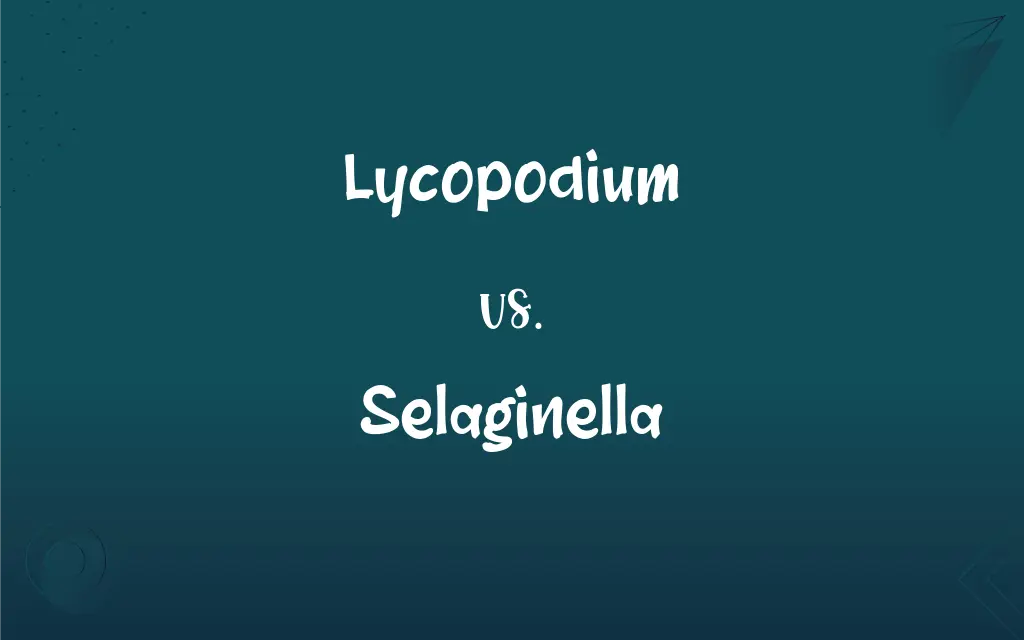Lycopodium vs. Selaginella: What's the Difference?
Edited by Aimie Carlson || By Janet White || Published on March 4, 2024
Lycopodium is a genus of clubmosses with needle-like leaves, while Selaginella, the spike mosses, are known for their scale-like leaves and moisture-loving nature.

Key Differences
Lycopodium, also known as clubmoss, represents a genus of ancient vascular plants characterized by their needle-like or scale-like leaves and growth in dense, carpet-like mats. Selaginella, often referred to as spike moss, belongs to a different genus within the lycophyte group, distinguished by its scale-like leaves, which can change color in response to moisture levels, and its unique ability to survive desiccation.
The reproductive strategies of Lycopodium and Selaginella also differ significantly. Lycopodium reproduces through spores produced in cone-like structures at the tips of the stems, while Selaginella species may possess both mega and microsporangia on the same plant, allowing for a more complex reproductive cycle involving both spores and the potential for sexual reproduction.
Ecologically, Lycopodium species are often found in forest understories, thriving in cool, moist environments. In contrast, Selaginella species exhibit a wide range of habitats; some thrive in similar conditions to Lycopodium, while others, like Selaginella lepidophylla (the resurrection plant), are adapted to extremely arid environments and can survive almost complete desiccation.
Morphologically, Lycopodium plants typically exhibit a more uniform appearance with their club-like tips, from which they derive their common name. Selaginella, however, showcases a greater diversity in form and coloration, with some species featuring iridescent blue or metallic green foliage, making them popular in horticulture for their ornamental value.
In terms of use, Lycopodium spores have been utilized historically for various purposes, including as flash powder in photography and as a coating for pills in pharmaceuticals due to their hydrophobic properties. Selaginella species, on the other hand, are primarily used for decorative purposes, especially in terrariums and as ground covers, due to their resilience and attractive foliage.
ADVERTISEMENT
Comparison Chart
Common Names
Clubmoss
Spike moss, Resurrection plant
Leaf Type
Needle-like or scale-like leaves
Scale-like leaves, often iridescent
Reproduction
Spores produced in cone-like structures
Both mega and microsporangia present
Habitat
Forest understories, cool and moist
Diverse, from moist forests to arid deserts
Uses
Flash powder, pill coating
Ornamental, especially in terrariums
ADVERTISEMENT
Lycopodium and Selaginella Definitions
Lycopodium
Reproduces through spores contained in cone-like structures.
The club-like tips of Lycopodium are actually spore-producing structures.
Selaginella
Adaptable to a wide range of habitats, including arid regions.
Selaginella lepidophylla, or the resurrection plant, can survive extreme dryness.
Lycopodium
Found in cool, moist environments, typically in forest understories.
We spotted several Lycopodium species during our hike in the misty woods.
Selaginella
A diverse genus of plants commonly known as spike mosses.
Selaginella kraussiana is a popular choice for adding greenery to indoor spaces.
Lycopodium
A genus of ancient vascular plants known as clubmosses.
Lycopodium clavatum is commonly used in homeopathy for its healing properties.
Selaginella
Features scale-like leaves that can change color based on moisture.
The Selaginella plant turned a vibrant green shortly after watering.
Lycopodium
Characterized by needle-like or scale-like leaves.
The dense mat of Lycopodium made the forest floor look lush.
Selaginella
Prized in horticulture for its ornamental value, especially in terrariums.
My terrarium looks vibrant with the addition of colorful Selaginella.
Lycopodium
Historically used for various purposes, including flash powder.
Lycopodium spores are highly flammable, once used in early photography for lighting.
Selaginella
Exhibits a complex reproductive cycle with both mega and microsporangia.
The reproductive structures of Selaginella are fascinating and complex.
Lycopodium
A plant of the genus Lycopodium, which includes many of the club mosses.
Selaginella
Any of numerous often creeping or prostrate vascular plants of the genus Selaginella that bear spores, have small scalelike leaves, and are closely related to the club mosses. Also called spikemoss.
Lycopodium
The yellowish powdery spores of certain club mosses, especially Lycopodium clavatum, formerly used in fireworks and explosives and as a covering for pills.
Selaginella
Any of a group of ferny plants of the genus Selaginella, spike moss.
Lycopodium
Club moss
Selaginella
A genus of cryptogamous plants resembling Lycopodia, but producing two kinds of spores; also, any plant of this genus. Many species are cultivated in conservatories.
Lycopodium
A genus of mosslike plants, the type of the order Lycopodiaceæ; club moss.
Selaginella
Type and sole genus of the Selaginellaceae; evergreen mosslike plants: spike moss and little club moss
Lycopodium
Type and sole genus of the Lycopodiaceae; erect or creeping evergreen plants often used for Christmas decorations
FAQs
What is unique about Selaginella's reproduction?
Selaginella has a complex reproductive cycle involving both mega and microsporangia, allowing for sexual reproduction.
Do all Lycopodium species prefer moist environments?
While most Lycopodium species thrive in moist conditions, some can adapt to drier habitats.
Can Selaginella grow in dry conditions?
Yes, some Selaginella species, like the resurrection plant, can survive extreme dryness by going dormant.
What is Lycopodium?
Lycopodium is a genus of vascular plants known as clubmosses, characterized by their needle-like leaves.
What are some uses of Lycopodium?
Historically, Lycopodium spores have been used in flash powder and as a coating for pills.
What distinguishes Selaginella from Lycopodium?
Selaginella, or spike mosses, are known for their scale-like leaves and ability to survive in diverse habitats.
How do Lycopodium plants reproduce?
Lycopodium reproduces through spores produced in cone-like structures at the stem tips.
Where can you typically find Lycopodium growing?
Lycopodium is commonly found in cool, moist forest understories.
What is the significance of the cone-like structures on Lycopodium?
These structures produce spores and are key to Lycopodium's reproductive process.
Can Lycopodium be used in landscaping?
Yes, Lycopodium can be used in landscaping, particularly in shady, moist garden areas.
What is the historical significance of Lycopodium spores?
Lycopodium spores have been used in various applications, including as a flash powder in early photography.
Is Selaginella easy to care for as a houseplant?
Selaginella can be easy to care for with adequate moisture and indirect light, making it suitable for indoor environments.
Why is Selaginella popular in horticulture?
Selaginella is prized for its ornamental value, especially in terrariums and as ground covers.
How does Selaginella react to watering?
Many Selaginella species change color, becoming more vibrant when hydrated.
How do you propagate Selaginella?
Selaginella can be propagated through division or spores, depending on the species.
Is Lycopodium endangered?
Some Lycopodium species are considered rare or endangered due to habitat loss and overharvesting.
Are all Selaginella species small and ground-hugging?
While many are, some Selaginella species can grow relatively tall and bushy.
How does Selaginella's ability to survive desiccation work?
Selaginella can lose most of its water content and enter a dormant state, reviving when rehydrated.
Are there any medicinal uses for Lycopodium?
Some species of Lycopodium have been used in traditional medicine, though their efficacy and safety can vary.
Can Selaginella tolerate direct sunlight?
Most Selaginella species prefer indirect light and can be damaged by prolonged exposure to direct sunlight.
About Author
Written by
Janet WhiteJanet White has been an esteemed writer and blogger for Difference Wiki. Holding a Master's degree in Science and Medical Journalism from the prestigious Boston University, she has consistently demonstrated her expertise and passion for her field. When she's not immersed in her work, Janet relishes her time exercising, delving into a good book, and cherishing moments with friends and family.
Edited by
Aimie CarlsonAimie Carlson, holding a master's degree in English literature, is a fervent English language enthusiast. She lends her writing talents to Difference Wiki, a prominent website that specializes in comparisons, offering readers insightful analyses that both captivate and inform.
































































